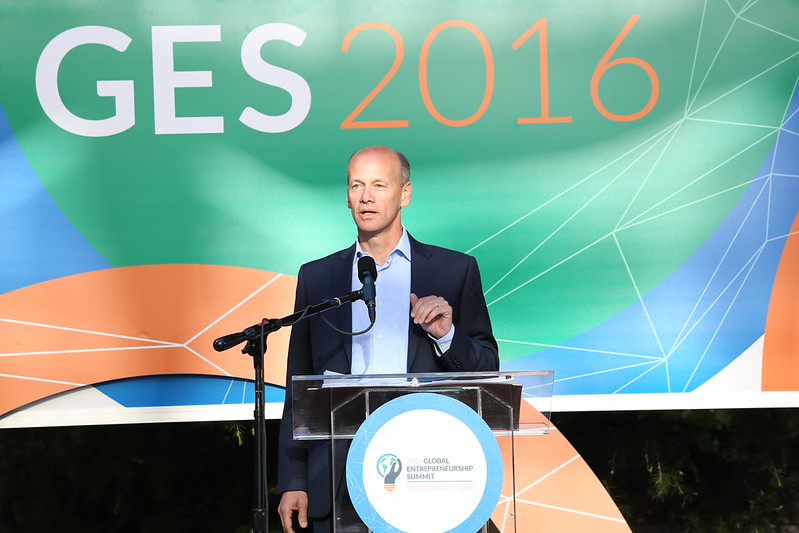
Greg Becker, President and Chief Executive Officer of Silicon Valley Bank and SVB Financial Group, gives remarks at the welcome reception for the Global Entrepreneurship Summit, held on June 22-24, 2016 at Stanford University in Palo Alto, California. [GES Photo/Public Domain]
Though often ignored, the various loan and credit guarantees provided by the federal government via a series of off‐budget enterprises are an insidious threat to American taxpayers. The oldest of these is the Federal Home Loan Bank (FHLB) system, a government‐sponsored enterprise (GSE) created to support the housing market. Since its foundation, the FHLBs have come to support more than just housing. The system’s mission creep, combined with the various privileges it enjoys from the federal government, has allowed it to cater to special interests and to inject moral hazard into the broader financial system. The system puts taxpayers at risk and should, at the least, be privatized if not eliminated. The FHLB system, for those unfamiliar, was founded before the New Deal. It was the brainchild of Herbert Hoover, who hoped to promote homeownership while supporting the Savings and Loan industry through the turmoil of the Great Depression. Established in 1932, the system was modeled after the Federal Reserve, with twelve regional banks cooperatively owned by the various financial institutions within their respective districts. Its membership was initially restricted to savings and loan associations (thrifts), financial institutions that specialized in mortgage lending. At first, the FHLB system only provided low‐cost loans to thrifts to aid their mortgage origination. Over time, though, the system expanded to lend to commercial banks to support all kinds of lending. Recently it provided loans to Silicon Valley, Signature, and First Republic Banks, only one of which was connected to mortgage lending and even then only to a wealthy clientele. Much like its younger siblings, Fannie and Freddie, the FHLBs enjoy a $4 billion credit line with the Treasury Department, and their debt is eligible for purchase by the Federal Reserve. Additionally, the system’s earnings and dividends are exempt from federal, state, and local taxes. Unique to the FHLBs is its “super lien” status which places it ahead of other creditors, including the FDIC, for getting paid back should a bank they lend to collapse. These privileges allow the FHLBs to borrow from investors at near‐Treasury rates, the proceeds of which are then lent to member institutions at below‐market rates against eligible mortgage assets. Of course, lending rates charged by the FHLBs are still above the rates at which they borrowed, allowing them to earn substantial profits from these operations. These privileges mean that many market participants expect, correctly or not, that the federal government would stand behind the system’s debt. These privileges also provide a sizable subsidy to member institutions, estimated at being between $6–9.3 billion per year. Such a lucrative subsidy has attracted the attention of a variety of industry and interest groups, including large financial institutions and community development and housing advocacy groups, all eager for a slice of government largesse. Thus, through a combination of lobbying and advocacy by the system’s leadership (including at one point its regulator) the system has been allowed to expand well beyond the boundaries of its original purpose. Starting in 1989 a series of system expansions was log‐rolled through Congress with bipartisan support, resulting in commercial banks, federal and non‐federal credit unions, and community development financial institutions all gaining eligibility for system membership. In exchange for allowing these players access to the system’s facilities, the FHLBs were also tasked with providing support to affordable housing and community development programs. Thus, each district FHLB is required to contribute 10 percent of its profits to fund the construction of affordable housing projects. The system also provides incentives in the form of discounted loans for member institutions to invest in housing or community development projects in low‐income areas. Lastly, many regional FHLBs operate mortgage purchase programs for which a target percentage must have been originated for low‐ to medium‐income households. Even more recently, the FHFA has announced plans to include climate resiliency requirements into the system’s lending programs. The fact that all the FHLBs’ operations are off the federal government’s balance sheet means that politicians have less accountability than that which comes with regular congressional appropriations. The primary beneficiaries of the system’s mission creep have not been homeowners, but rather a handful of large banks who have routinely received the majority of the loans made by the banks. At the end of 2019, for instance, the ten largest members of the system accounted for 30 percent of its lending, with Wells Fargo and JPMorgan Chase accounting for most of this increase. These loans supported a variety of lending activities, not just home mortgages. Low‐income homebuyers have also benefitted from direct subsidies as the system expanded. But there has been no sustained increase in the rate of homeownership and housing itself has not become more affordable. The FHLB system also creates a great deal of moral hazard. For example, the system’s structure creates incentives for risk‐taking while simultaneously reducing the incentives of the banks’ bondholders and shareholders to monitor and constrain risky behavior. Two prime examples are the implicit guarantee of the system’s debt by the federal government and its “super lien” status. Bondholders understand these privileges as a signal that they are highly likely to be made whole if ever in danger of financial failure. On the flip side, shareholders and FHLB executives stand to earn substantial profits from bank risk‐taking. In 2022 the CEO of the San Francisco FHLB earned $2.4 million, a substantial portion of which was bonuses tied to growth in the bank’s lending. The effect of these perverse incentives has been that the FHLBs have made loans to failing institutions and have failed to properly manage their own risk‐taking. Taxpayers are the ultimate bearers of the system’s risk‐taking, both through the implicit guarantee of FHLB debt, and the regular bank resolution process. To reduce the risks both to taxpayers and the broader financial system, the FHLBs should be privatized, if not eliminated. To privatize the FHLBs, Congress should revoke their charters, thereby subjecting them to greater market discipline and greater incentives to constrain risk‐taking. By removing these privileges, the distortions created by this New Deal relic can be eliminated.
Read more here.
If you’re willing to fight for Main Street America, click here to sign up for my free weekly email.





